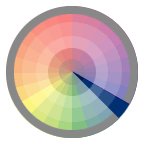Webster’s defines a color wheel as “a circular diagram of the spectrum used to show the relationships between the colors.” Yeah, it wasn’t helpful to me either in actually interpreting the wheel for practical use. Some further investigation of color and compatibility was needed.
The Players
The traditional color wheel consists of 12 colors. The first being the primary colors, which include red, yellow and blue.

If you combine two of the primaries, you will create either orange, green and purple, which are considered the secondary colors on the wheel.
The tertiary colors on the wheel are created by combining a secondary color and its primary neighbor. So, red + violet = red-violet.
T’s & S’s
Think tint, tone and shade mean the same thing? Apparently not, according to my research. Tint refers to the original color + white. Tone = original color + gray. Shade = original color + black.
On my particular color wheel, tint, tone and shade are represented in the individual “slices” of the pie.

Feel the Heat
All colors have a temperature. On the traditional color wheel, yellow-green to violet are considered cool (or passive), whereas yellow to red-violet are considered warm (or active).

You might want to keep a color’s temperature in mind when considering the exposure of a room. Rooms facing north, which generally feel cool, might benefit from a warm color, whereas rooms with a southern exposure might benefit from a cool color.
Of course, the climate in which you live might dictate your choice as well. A cool green interior might provide some relief from the heat outside, whereas a spicy red is sure to warm up a snowy winter.
Color Hook-Up
One rule to help ensure a good color hook-up includes, I’m afraid to say, incest. Colors from the same family generally look great together. For reference, just take a look at the individual sections of the wheel. Every color represented in that slice are good bets for a satisfying hook-up.

Another compatibility rule involves friends with benefits. This is when you use color combinations that are next door to each other on the wheel. So, for blue these would include blue-green and blue-violet. Hey, a Crayola ménage à trois!

A third rule of thumb is the bad boy theory, or the opposites attract theory. This is when you pair one color with the color opposite from it on the wheel. Such hook-ups are called complementary colors. For example, blue is the complement of orange. One complement is always warm whereas the other is always cool. Ain’t that always the way?

Post-Coital Color Summary
If you long for color but are afraid to take the leap, referring to a color wheel can take the mystery out of the process and thus eliminate the fear. It’s almost a guarantee that after the first-hook up you’ll become a color slut, which means you can ditch the color-wheel and go commando.

To find traditional color wheels, interior design and gardening color wheels, visit The Color Wheel Company to find a retailer near you. For more information than you probably ever wanted to know about color theory, check out www.worqx.com/color.
Color pencil wheel courtesy of TyC @ Flickr.
